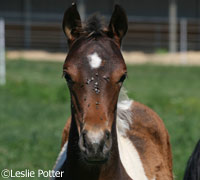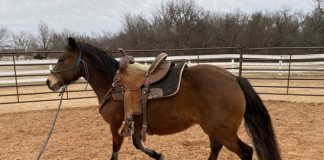
Environmentally conscious horse owners are also looking for equine products and services that are friendlier toward our world. As a result, manufacturers of insect control products are providing alternatives to horse owners who really do want to be as environmentally responsible as possible. Here’s a look at insect control strategies that help minimize environmental risks while still offering comfort to our horses throughout fly season.
The Bug Stops Here
The best insect control strategy starts with eliminating the sources that attract bugs in the first place. Follow these basic horsekeeping guidelines to help rid your property of insect attractants:
1. Pick up manure and soiled bedding daily from stalls, paddocks and pastures. Move the waste to a temporary storage area far away from horses. “Temporary” means you will move, compost or spread the manure later. (A heaping manure pile does NOT qualify as a composting method!) Consider covering the storage area with a tarp to help reduce fly breeding.
2. Eliminate standing water from your property. Stagnant water is prime breeding ground for mosquitoes and it attracts flies.
3. Remove and dispose of wet or spoiled feed/hay.
4. Keep your horses in breezy pastures or paddocks. Flies and mosquitoes don’t fare well in wind. If you keep your horses in a barn, make sure the stalls are well-ventilated. Consider installing fans in the barn to keep a constant breeze going.
5. Pick up trash and dispose of it in sealed, varmint-proof containers.
6. Care for open wounds. Flies feed on them. If your horse has a wound, clean and cover it (call your vet if it’s serious).
Secondary Strategies
Once good horsekeeping measures are in place, you will see a drop in pest insect populations around the barn. However, secondary strategies are often called for even in the cleanliest situations. For example, flywear offers a good barrier of protection against many insect species. But most flywear is made of nylon mesh, a material that doesn’t rank very high on environmentalists’ green lists, so if you opt to outfit your horse, make sure to choose durable, high-quality products that can be reused season after season.
“[Flywear] is not designed to be a single-use product,” says Harry Hayes, Ph.D., chemist, vice president of research and development, W.F. Young Inc., the makers of Absorbine. Flywear is offered by many companies, and W.F. Young/Absorbine markets the UltraShield Fly Bonnet, which is made of patented RipShield fabric that’s designed to withstand tears and rips. If the material is gouged, the weave can be moved back into place.
When your horse’s flywear finally does reach the end of its usable life, look for ways to recycle items, whether through a local recycler or by finding alternative uses for it around your home or barn. (Use the nylon mesh as a scrub rag to clean outdoor fixtures, for example.)
One green strategy that some horse owners have turned to is parasitic wasps, often referred to as fly parasites that go by the scientific names of Muscidifurax zaraptor, Muscidifurax raptorellus and Spalangia cameroni. They all belong to the wasp family but are harmless to humans, animals, plants and beneficial insects. Fly parasites insert their eggs into the pupae (immature stage) of several species of flies—mostly common houseflies and biting stable flies. The fly parasite larvae then feed inside the pupa, eventually killing it.
Several companies sell fly parasites, including Arbico Organics, Spalding Laboratories, and The Source Biological Fly Control. Grante Poole, a University of California Farm Advisor based in Lancaster, Calif., says parasitic wasps only harm flies. “I have not encountered any problems with these insects on crops and there isn’t any [environmental] impact with beneficial insects.”
Successful fly control with these parasites does depend on some factors. For example, smaller facilities will have more success with fly parasites because the treatment areas are limited. Also, you can’t indiscriminately spray pesticides, natural or not; otherwise you’ll kill off the fly parasites. Extremely windy conditions aren’t a good habitat for fly parasites either. Regular parasite release is crucial, usually about every four weeks during fly season.
Become an Informed Consumer
If you opt to use a fly spray, lotion or roll-on, read the label carefully. Any product on the market today that makes claims about killing, repelling or controlling insects is considered a pesticide and is therefore regulated by the Environmental Protection Agency (EPA) as well as every state in which the product is sold.
“Safety requirements have to be met, assuming the product qualifies under the definition of pesticide,” says Marion J. Johnson, Jr., with the EPA’s Insecticide Branch. “There has to be an application for pesticidal registration through the EPA. There’s also an efficacy requirement.”
However, there are exceptions. “There is a group of chemicals that the EPA has identified as ‘minimum risk chemicals (see “Innocuous Chemicals” below),’” says George LaRocca, product manager with the Insecticide Branch of the Registration Division, Office of Pesticides Program, EPA. These chemicals, which are mostly derived from natural ingredients, are considered to be relatively safe to the environment, including horses and humans. If a manufacturer uses only chemicals from this list in a product’s active ingredients, then that product is exempt from EPA regulation as long as any inert (non-active) ingredients pose minimum risks under federal rules. Fly control products in this category include Supershield Green (W.F. Young/Absorbine), Nature’s Defense (Farnam Companies Inc.), and many others.
Even though these products fly under the EPA’s radar, they may still be subject to individual state regulation. Also, any product that makes label claims about repelling ticks or mosquitoes is subject to EPA regulation. “Flies are a nuisance, but ticks and mosquitoes are a public health threat,” Johnson says. “If there’s a public health risk, then the exemption criteria are removed and they are subject to regulation.”
When using products containing “minimum risk” chemicals (often called “natural” products), you will probably need to reapply more often. “Generally, natural products have an efficacy duration that usually lasts for hours, so you’ll end up having to reapply the products more frequently,” Hayes says. “If you’re using products designed for high power, longer lasting efficacy, you’ll use less, but they will contain pesticides.”
The most common active ingredients in these high-power insect control products are usually pyrethrin and/or pyrethroids. Pyrethrin is a natural substance derived from chrysanthemums; pyrethroids are synthetic versions of pyrethrin. Synthetics are more stable in sunlight than pyrethrins, which means they’re more effective over a longer period of time. These synthetics go by many names, including permethrin and cypermethrin, to name a few. Pyrethrin and its synthetic cousins are classified as pesticides under EPA rules, and therefore are highly regulated. These chemicals are the most common pesticides found in fly control products for horses.
“The downfall of natural pyrethrin is that it breaks down in UV light pretty quick,” says Chris Jacobi, senior vice president, equine products, Farnam. However, Jacobi believes that one of his company’s EPA-approved pyrethrin-based products stands out and helps allay environmental concerns. Farnam’s Equisect, which is approved by the EPA and the Organic Materials Review Institute (OMRI), is designed to appeal to horse owners who want a natural product with as much power as possible.
“We didn’t chemically alter the product at all,” Jacobi says. “It contains all natural ingredients. The feedback from the field was positive last year, which was our first year out with the product. We’re seeing it continue this year.”
OMRI is a national nonprofit organization that determines which products are allowed for use in organic production and processing.
Regardless of the type of insect control product you’re using, natural or chemical-based, follow label directions carefully. “Pesticides are inherently toxic,” LaRocca says. “You have to read the label to ensure that you’re following any precautions to minimize potential exposure.” General application guidelines include avoiding overspray in the environment, and not using sprays near water sources. Some insecticides are toxic to fish. Do not apply where runoff is likely to occur, which includes using caution when rinsing your horses after fly spray application.
Regarding environmental concerns about feed-through products designed to control flies, manufacturer representatives and the EPA all advise to closely read product labels. While these products contain larvicides rather than pesticides, they are still highly regulated by the EPA. (Feed-through products have been found to be effective and work by passing through the horse’s gut, and then out with manure where flies lay eggs. Larvicides in the feed-through prevent eggs from hatching in manure.) Strict EPA regulation not only means a product has to pass safety and efficacy standards, it also means the agency closely reviews product label claims, including wording about potential environmental toxicities. Look for feed-through products that contain no organophosphates, which are harmful to the environment. SolitudeIGR (Pfizer), Simplfly (Farnam) and Equitrol (Farnam) are a few of the feed-through products that don’t contain organophosphates.
Another larvicide-based product group is mosquito dunks. These products are used in stock tanks and ponds to kill mosquito larvae. The safest products include those in the microbial larvicide category. The active ingredients in these mosquito dunks are naturally occurring bacteria (Bacillus thuringiensis israelensis and Bacillus sphaericus) that the EPA has classified as nontoxic to the environment, including humans, animals and fish.
Many insect traps and baits are on the market today; some contain pesticides, although many don’t. Traps and baits are best used away from horses—after all, you don’t want flies congregating too nearby. Look for products that don’t contain pesticides and follow label directions carefully.
Next time you purchase a fly control product, read the label and consider environmental risks. Protecting your horse against insects and being conscientious about our planet is good for all.
Further Reading
Natural Fly Control
Fly Control Products







I would be interested in your take on malathion fogging, We have a breeding farm, and last year our property was fogged by our county program, about every 8-10 days, in the evening. All of our mares went to pasture the week before they started fogging, and in foal anywhere from 28 days to 60 days, of the 20 mares we have here at the farm
we had 16 empty mares. I have been researching and have found that though tested, Malathion has not been specifically tested in the impact it has/would have on early embronic death. Our mares went to pasture with active heat measures and ultra sounded to be in foal. I have been reading that any environmental teratogens can have tragic impact on early embronic stages of pregnancy.
We are not having our farm fogged this year, all of our mares are in foal, which heart records, anxious to see if we have a different spring. We have been a breeding farm for 15 years, and we have always had greater then 50% live foals, more in the 78% live foals. We had 6 live foals, the mares that were settled early in the year, Feb/Mar foaled, the mares that were in a pastrue that didn’t get fogged, had live foals, client mares that came to the farm and didn’t stay the summer, had live foals. This has been a great frustration to us, as that many empty mares is a huge loss of income to the farm. Do you have any thoughts or comments. Thank you very much., Very good article, we actively pursuing a more Green effort in control of flys and misquitoes. We are going to try oil of lavender on us and animals. Read it in a magazine, I am gonna cut it with mineral oil, and use sparenly.